The internationally inspired ‘North Edinburgh Grows’ community garden was selected by the 2014 SURF Awards judging panel as winner of the Creative Scotland supported ‘Creative Regeneration’ category. Kate Wimpress, who oversaw the project from the outset, describes its journey, starting in 2008 when her arts organisation wished to get rid of the then waste ground space.
When it comes to project planning, where do chance discoveries, unexpected turns and new ideas fit in?
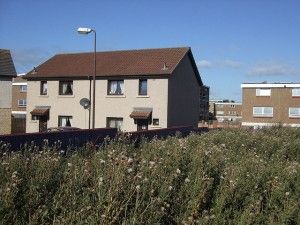
The garden was originally overgrown with weeds (image courtesy of Denna Jones via Flickr)
They all sound risky, but in fact it can lead to both expected and desired outcomes, so long as you have the right framework in place.
That was certainly our experience when we created the SURF Award-winning garden in the heart of Muirhouse in north Edinburgh. The garden is flourishing now, but rewind six years and it felt like a liability – one that I was trying my best to ignore.
Sowing Seeds
North Edinburgh Arts (NEA) was in fairly poor shape when I joined the organisation at the start of 2008. There was no programme to speak of and only a skeleton staff. Ongoing financial woes were matched by indifferent neighbours. We were heading fast into the sort of white elephant country where good ideas sometimes go to die.
To my mind, the building and its surrounding community were the key assets. Its garden (what garden?!) was, however, something we could, maybe, get rid of altogether at some point to shore up the developing activities inside.
 Major regeneration plans were afoot for the area so it seemed pertinent for NEA to be involved, with a focus on public art. NEA got support from the then Scottish Arts Council to bring in Denna Jones FRSA, architectural writer and urban regeneration consultant.
Major regeneration plans were afoot for the area so it seemed pertinent for NEA to be involved, with a focus on public art. NEA got support from the then Scottish Arts Council to bring in Denna Jones FRSA, architectural writer and urban regeneration consultant.
Denna’s task, in the words of the funding agreement, was to:
“Engage, influence and inform planners and the community about the possibilities for public art integral to the planned regeneration of Pennywell and Muirhouse”
Spring Shoots
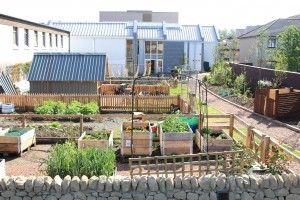
Following development, the garden opened in June 2014
In partnership with a range of artists, residents and colleagues, Denna led a dynamic and forward-thinking two-year programme. Visual preference surveys, major commissions, articles in the national press, site visits and creative workshops kept leading back to one thing. Top of local residents’ wish-list was a desire for, and interest in, quality green space.
Ah! Better keep that garden after all then. It isn’t a liability, it is a key cultural asset, both for the local community and for the organisation. Persuaded, we turned our attention outdoors, and started the project we named North Edinburgh Grows.
Wide-ranging community support and assistance from Edinburgh & Lothian Greenspace Trust, Anta Architects, and Denna again, amongst many others, helped secure project funding from Big Lottery Community Spaces Scotland.
We were able to turn the half acre of neglected scrubland into the inspiring, creative, growing space it is now.
Four Simple Gardening Tips
It has been the riskiest – yet smoothest – project I have been charged with delivering. Why? I managed to boil it down to four main conclusions. First, the structured ‘chaos’ a creative approach engenders is a good thing. As long as you are clear about the framework, you can afford to let the detail evolve collaboratively.
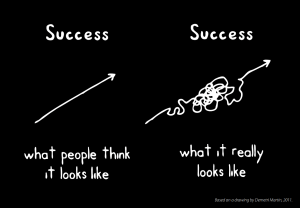 On the subject of being clear, my second conclusion is: make sure you know what can – and can’t – be influenced.
On the subject of being clear, my second conclusion is: make sure you know what can – and can’t – be influenced.
Third, involve the right people; not just the obvious ones. And on this one, trust and a shared vision are invaluable.
Finally, keep a ‘success diagram’ to hand. That’s the one with a straight arrow showing what people think success looks like, next to a squiggly arrow depicting what happens in reality, as pictured to the right.
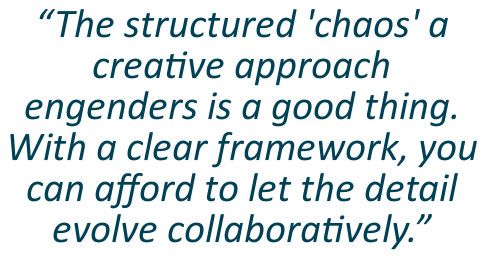
Coming Up Roses
The garden has changed the way we think and the way we do things. I’m confident it will continue to be a welcome new green space in a part of Edinburgh that isn’t over-endowed with such places.
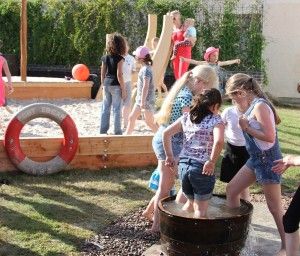
The new space is popular with local children
In the future we plan, through partnerships with City of Edinburgh Council’s 21st Century Homes programme, to extend the best elements of the garden across the local regeneration ‘zone’. It has inspired us to ask what we can shape and where it might be possible for people to manipulate plans.
Beyond NEA and north Edinburgh, perhaps more of us need – collectively – to find new ways of marrying the obvious strengths of major regeneration players with the very different attributes of nimble, risk-embracing, human-scaled organisations like ours.
As I said at the beginning, chance discoveries, unexpected turns and new ideas all make life a bit more interesting (perhaps too interesting!) for larger organisation. Yet they can still lead to a particular set of desired outcomes.
Will we be getting any off-the-peg play equipment to go in our new garden? No thanks: we’d rather build our own bespoke space rocket… and probably save some money in the process.
